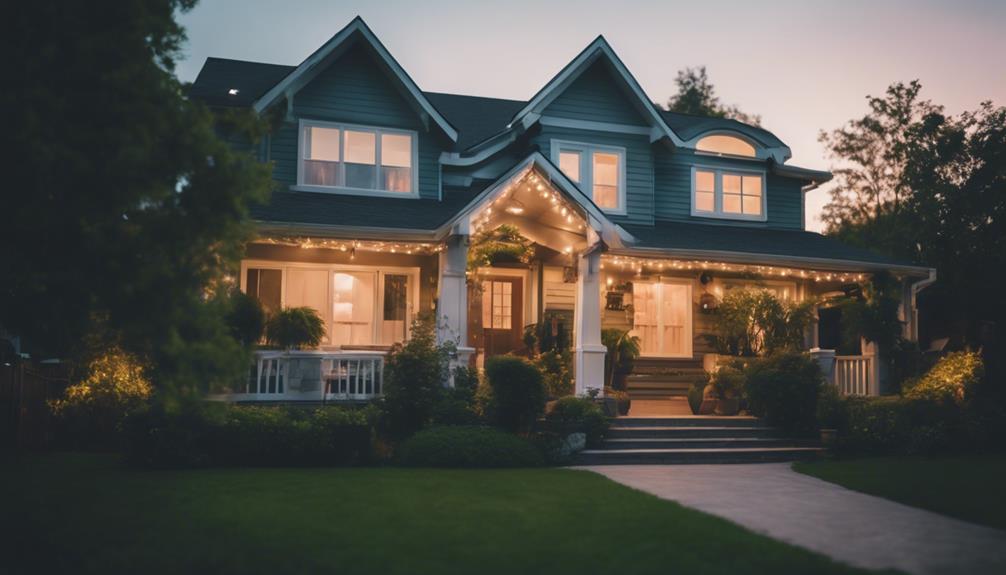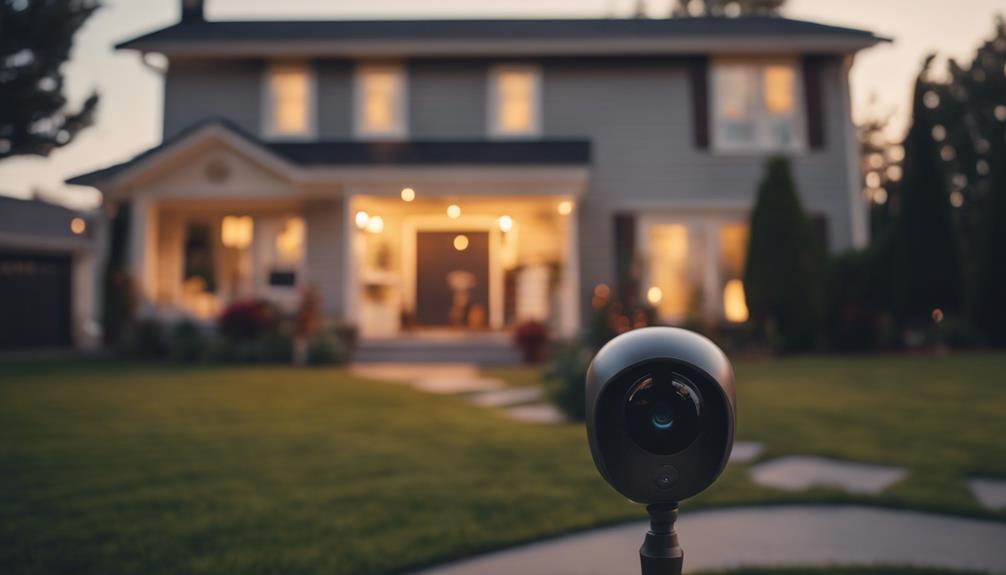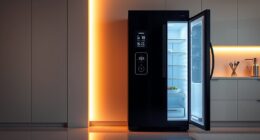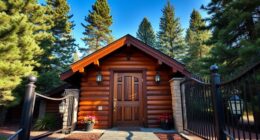To plan your home security system, start by evaluating all entry points like doors and windows. Consider your home's layout to identify blind spots. Install security sensors on each entry to maximize coverage. Choose between self-monitoring or professional options based on your budget and needs. Incorporate essential equipment such as at least 1080p cameras, smart locks, and environmental sensors for thorough protection. Don't overlook the benefits of regular system checks and maintaining your security impression. By following these steps, you'll create a solid safety foundation, and there's more to explore on setting up your ideal system. For a complete home security system overview, consider adding motion detectors and glass break sensors to further fortify your defense. Additionally, think about integrating your security system with home automation for added convenience and control. By taking a comprehensive approach to your home security, you can enjoy peace of mind and ensure the safety of your family and property.
Key Takeaways
- Assess all entry points, including doors and windows, to identify vulnerabilities and install security sensors accordingly.
- Choose between self-monitoring for budget savings or professional monitoring for 24/7 oversight and quicker emergency response.
- Invest in high-quality security cameras with at least 1080p resolution for clear video and essential night vision capabilities.
- Include environmental sensors to monitor smoke, carbon monoxide, and water leaks for comprehensive home safety.
Importance of Home Security
Home security is essential because it not only protects your property but also enhances your peace of mind. By investing in home security systems, you greatly reduce the risk of becoming a victim of a security threat. Homes equipped with security measures are three times less likely to be burglarized. This extensive protection extends beyond theft; it includes monitoring for hazards like smoke and flooding, ensuring your home remains safe in various situations.
Additionally, incorporating advanced features such as smartphone connectivity and security alerts in your security system can further enhance protection and convenience.
Moreover, installing a DIY home security system can be a cost-effective option. While upfront costs for installation and maintenance may seem intimidating, they're minor compared to the financial and emotional toll of a break-in, which averages over $2,300. Additionally, many insurance companies offer discounts on homeowners insurance for monitored systems, which can range from 2% to 20%.
Taking preventive measures against package theft and other risks helps secure not just your belongings but also your well-being. With a solid security plan in place, you can enjoy a greater sense of safety and tranquility at home.
Planning Your Security System

When planning your security system, start by evaluating all entry points in your home, like doors and windows, to figure out where to place sensors.
It's also wise to take into account the layout of your home and potential blind spots that may need additional coverage.
Additionally, you might explore various home cleaning service options to guarantee that your home remains clean and presentable, which can enhance the overall security impression.
You'll also want to choose monitoring options that fit your lifestyle and provide easy access without compromising visibility.
This strategy sets the foundation for a robust security setup that keeps your home safe.
Assess Entry Points
Evaluating all potential entry points is essential for effectively planning your security system. Start by examining your windows and doors, as these are primary targets for burglars.
To enhance your home's safety, consider incorporating features like modern ceiling fans that improve airflow while reducing reliance on air conditioning, resulting in lower energy bills and a more comfortable environment, especially during warmer months energy savings and comfort.
Install security sensors on each entry point to guarantee maximum coverage. Don't forget to evaluate elevated access points like decks, which can also be vulnerable to intruders.
To further protect your home, reinforce these entry points. Upgrade your locks and secure door jambs to make it more difficult for burglars to gain access through common methods like kicking or prying. Regularly inspect your security sensors to verify they're functioning correctly, and adjust their placements based on any changing vulnerabilities.
Consider not only your main floor but also any basement or attic windows, as these can be overlooked. Securing all openings will help you avoid security oversights that could compromise your home.
Choose Monitoring Options
Selecting the right monitoring option for your security system is essential for guaranteeing your home stays protected. You have two main choices: self-monitoring or professional monitoring.
Self-monitoring is budget-friendly, using mobile apps for instant alerts, but it requires your immediate attention during emergencies. Additionally, many self-monitoring systems leverage AI-driven solutions to enhance threat detection, making it easier to identify potential security breaches.
On the other hand, professional monitoring offers 24/7 oversight and can contact authorities on your behalf when needed, providing peace of mind.
When choosing, consider these factors:
- Budget: Self-monitoring generally has no monthly fees, while professional services can cost between $10 and $49.99/month.
- Integration: Confirm your monitoring option works seamlessly with your home security system for effective alerts.
- Contract Terms: Many professional services offer flexible month-to-month plans, allowing you to adapt as your needs change.
Ultimately, weigh your options carefully to find the best fit for your lifestyle and security needs.
Key Components to Consider

To effectively enhance your home's security, you should regularly assess key components like security cameras, sensors, and smart locks.
It's vital to take into account the emotions and behaviors of your pets, as they may also contribute to your home's security; for example, cats exhibit signs of attachment that can alert you to unusual activities.
Start with security cameras, aiming for at least 1080p resolution to guarantee clear video quality. Think about using both outdoor cameras for external monitoring and indoor cameras for interior surveillance.
Next, install door and window sensors to alert you to unauthorized openings. Motion sensors are also important; they detect movement around your property, providing an extra layer of security.
Don't forget about environmental sensors, which can alert you to smoke, carbon monoxide, or water leaks, enhancing overall safety.
Smart locks are another key component. They integrate seamlessly with your security system, allowing for remote access control and convenient management of home entry.
Additionally, plan for a control panel that's easily accessible in emergencies while remaining discreet to deter intruders.
If you're interested in DIY installation, many modern systems allow for this, making it easier to customize your setup.
Incorporating these key components will create a thorough security system tailored to your needs.
Camera Options for Surveillance

When it comes to camera options for surveillance, you'll want to take into account both indoor and outdoor features.
Indoor cameras should provide clear video quality and smart home integration,
while outdoor cameras need to withstand the elements with night vision and motion detection.
Additionally, incorporating smart organization techniques can help streamline your home security system setup.
Indoor Camera Features
Indoor cameras play an essential role in home security by providing high-definition video and advanced features that enhance your surveillance capabilities. When choosing an indoor camera, consider the following key features to guarantee effective monitoring of your home:
Additionally, incorporating surveillance options like gold IRA rollovers can bolster your financial security, similarly to how a good security camera enhances your physical security.
- Video Quality: Look for cameras with at least 1080p resolution for clear images.
- Night Vision: Confirm the camera has night vision capabilities for monitoring in low-light conditions.
- Motion Detection: This feature alerts you to unusual activity, allowing for timely responses to potential threats.
Advanced indoor cameras, like the Eufy Indoor Cam 2K and Wyze Cam V3, offer additional features such as facial recognition and cloud storage for recorded footage.
These security devices not only enhance your peace of mind but also make it easier to manage your home's safety.
Outdoor Surveillance Options
Outdoor surveillance options are essential for safeguarding your property, and choosing the right camera can greatly enhance your security setup. When selecting outdoor cameras, look for features like weatherproofing to guarantee durability against the elements. A minimum of 1080p resolution is recommended for clear video quality, helping you identify people and details effectively.
Many outdoor surveillance cameras are equipped with motion detection capabilities, which activate recording when movement is sensed, considerably improving your security coverage. Advanced models may include night vision and facial recognition technology, allowing you to monitor your property even in low-light conditions. Additionally, doorbell cameras provide a unique advantage; they not only record visitors at your entrance but also offer real-time viewing and notification when the doorbell is pressed.
Here's a quick comparison of outdoor camera features:
| Feature | Description |
|---|---|
| Weatherproofing | Resists rain, snow, and extreme temperatures |
| Motion Detection | Triggers recording upon detecting movement |
| Night Vision | Enables viewing in low-light conditions |
| Facial Recognition | Identifies individuals for enhanced security |
| Doorbell Cameras | Offers real-time alerts and video of visitors |
Monitoring Your Security System

Monitoring your security system effectively guarantees you stay informed and can respond quickly to any potential threats. You have two primary options: self-monitoring or professional monitoring.
Self-monitoring is cost-effective, using smartphone apps to send you alerts and real-time notifications about any breaches. This way, you can take immediate action during emergencies.
On the other hand, professional monitoring provides 24/7 coverage, handling alerts continuously and notifying authorities directly for a monthly fee.
Consider the following benefits of each option:
- Real-time alerts: Stay updated on your home's security status.
- Remote monitoring: Access your security system from anywhere, anytime.
- Insurance discounts: Save up to 20% on your premiums with monitored systems.
Whichever route you choose, confirm your security systems are set up for effective monitoring.
You'll not only enhance your home's safety but also enjoy peace of mind, knowing you can respond swiftly to any potential threats.
Choosing the Right Equipment

Selecting the right equipment is vital for building an effective home security system that meets your specific needs and enhances your overall safety.
Start with security cameras; aim for at least 1080p resolution to guarantee clear video quality. Models like the Arlo Pro 4 or Wyze Cam V3 are great choices for effective monitoring.
Don't forget about door and window sensors—install them on all entry points to minimize vulnerabilities. Each operable window and door should have its own sensor.
Next, consider smart locks that can connect with other security devices. The Kwikset Halo Touch, for example, allows for remote access and control, adding convenience to your security.
Incorporating environmental sensors like smoke, carbon monoxide, and water leak detectors is also important. Devices such as the Flo by Moen Smart Water Detector can alert you to potential hazards.
Frequently Asked Questions
How to Plan a Security System?
To plan a security system, assess your entry points, choose appropriate sensors and cameras, guarantee a discreet control panel location, and consider additional safety measures like smoke detectors and outdoor lighting for thorough protection.
How to Choose the Right Home Security System?
Did you know that homes without security systems are 300% more likely to be burglarized? To choose the right home security system, assess your needs, compare brands, and guarantee essential features suit your lifestyle and budget.
Can I Install a Home Security System Myself?
Yes, you can install a home security system yourself. Many DIY options are user-friendly, requiring no special skills. You'll save money and time while customizing the setup to fit your specific security needs.
Where to Start With Home Security?
Starting with home security feels like fortifying a castle! Assess all entry points, install sensors where needed, and enhance visibility with lighting. Create a solid plan, focusing on vulnerabilities, to keep your home safe and sound.
Conclusion
So, after all this talk about securing your castle, you might think you're ready to become a home security expert.
But remember, while your fancy cameras and alarms are keeping the bad guys at bay, they won't help you figure out how to stop your neighbor's cat from using your garden as a litter box.
So, go ahead and plan that security system—just don't forget to invest in some cat repellent while you're at it!









